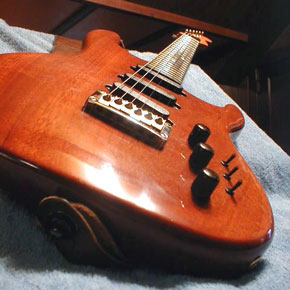Steve_Karl
Hero Member
- Messages
- 1,733
Greetings,
First let me say I'm a total novice when it comes to finishing. The only 2 finishes I've ever done were: 1) a brush on clear, on a ' 62 p-bass ( yea, I'll bend over and you can kick me ) and my current Warmoth neck using Master Gel.
The master jell is really nice and much better than the water based finish that was on the neck originally. It feels raw yet smooth and is very very easy to keep clean, unlike the body, which is still the old water based and is always either sticky, smudged or just plain nasty, and is very hard to clean.
So ... I'm ready to order parts for a new strat and it will be a mahogany body and I would like it to look similar, in color, to this one:

Not so much the shine, I can live without that, and I'm going to use master gel again, but the color.
I'm guessing that it was dyed before the water based finish was applied.
Can someone recommend something easy to apply that will give this gentle orange brown look, still showing all the grain, and work well with master gel?
Also, is there any prep. necessary before dye or stain or the new, unfinished mahogany body?
And I'd like to avoid, if possible, products that are difficult to clean up after.
Eventually, I'll also be stripping the body on the one in the pic, ( all it takes is some windex and light steel wool and paper towels ) and will be then using master gel, so it would be good to get a dye or stain that is close to the original in case I have to touch up some areas after removing the old finish.
An other thing I'd appreciate some advice on is how aggressive to be in the removal of the old finish. Can I get away with just getting it all to look consistent and flat, and feel smooth?
With the neck, I just steel wooled it down to where it felt good and no longer tacky, but it's a maple and had no stain or dye under or mixed with the original finish. I'm happy with how it turned out.
Thank you!
First let me say I'm a total novice when it comes to finishing. The only 2 finishes I've ever done were: 1) a brush on clear, on a ' 62 p-bass ( yea, I'll bend over and you can kick me ) and my current Warmoth neck using Master Gel.
The master jell is really nice and much better than the water based finish that was on the neck originally. It feels raw yet smooth and is very very easy to keep clean, unlike the body, which is still the old water based and is always either sticky, smudged or just plain nasty, and is very hard to clean.
So ... I'm ready to order parts for a new strat and it will be a mahogany body and I would like it to look similar, in color, to this one:

Not so much the shine, I can live without that, and I'm going to use master gel again, but the color.
I'm guessing that it was dyed before the water based finish was applied.
Can someone recommend something easy to apply that will give this gentle orange brown look, still showing all the grain, and work well with master gel?
Also, is there any prep. necessary before dye or stain or the new, unfinished mahogany body?
And I'd like to avoid, if possible, products that are difficult to clean up after.
Eventually, I'll also be stripping the body on the one in the pic, ( all it takes is some windex and light steel wool and paper towels ) and will be then using master gel, so it would be good to get a dye or stain that is close to the original in case I have to touch up some areas after removing the old finish.
An other thing I'd appreciate some advice on is how aggressive to be in the removal of the old finish. Can I get away with just getting it all to look consistent and flat, and feel smooth?
With the neck, I just steel wooled it down to where it felt good and no longer tacky, but it's a maple and had no stain or dye under or mixed with the original finish. I'm happy with how it turned out.
Thank you!


